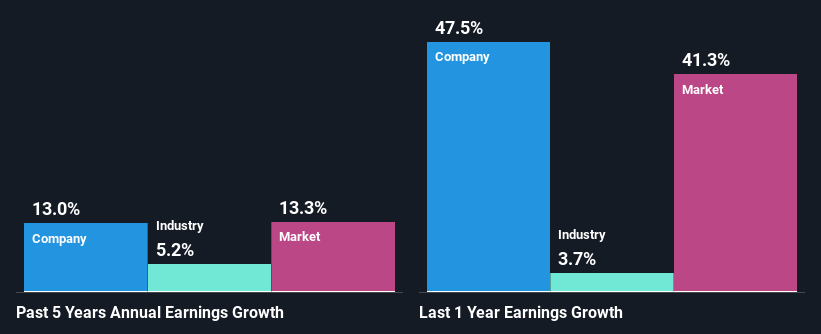Are Robust Financials Driving The Recent Rally In Otter Tail Corporation's (NASDAQ:OTTR) Stock?
Otter Tail's (NASDAQ:OTTR) stock is up by a considerable 30% over the past three months. Since the market usually pay for a company’s long-term fundamentals, we decided to study the company’s key performance indicators to see if they could be influencing the market. Particularly, we will be paying attention to Otter Tail's ROE today.
Return on Equity or ROE is a test of how effectively a company is growing its value and managing investors’ money. In other words, it is a profitability ratio which measures the rate of return on the capital provided by the company's shareholders.
View our latest analysis for Otter Tail
How Do You Calculate Return On Equity?
ROE can be calculated by using the formula:
Return on Equity = Net Profit (from continuing operations) ÷ Shareholders' Equity
So, based on the above formula, the ROE for Otter Tail is:
15% = US$144m ÷ US$952m (Based on the trailing twelve months to September 2021).
The 'return' is the income the business earned over the last year. So, this means that for every $1 of its shareholder's investments, the company generates a profit of $0.15.
What Is The Relationship Between ROE And Earnings Growth?
Thus far, we have learned that ROE measures how efficiently a company is generating its profits. Based on how much of its profits the company chooses to reinvest or "retain", we are then able to evaluate a company's future ability to generate profits. Assuming all else is equal, companies that have both a higher return on equity and higher profit retention are usually the ones that have a higher growth rate when compared to companies that don't have the same features.
Otter Tail's Earnings Growth And 15% ROE
To begin with, Otter Tail seems to have a respectable ROE. Especially when compared to the industry average of 9.5% the company's ROE looks pretty impressive. This probably laid the ground for Otter Tail's moderate 13% net income growth seen over the past five years.
Next, on comparing with the industry net income growth, we found that Otter Tail's growth is quite high when compared to the industry average growth of 5.2% in the same period, which is great to see.
The basis for attaching value to a company is, to a great extent, tied to its earnings growth. What investors need to determine next is if the expected earnings growth, or the lack of it, is already built into the share price. By doing so, they will have an idea if the stock is headed into clear blue waters or if swampy waters await. If you're wondering about Otter Tail's's valuation, check out this gauge of its price-to-earnings ratio, as compared to its industry.
Is Otter Tail Efficiently Re-investing Its Profits?
The high three-year median payout ratio of 64% (or a retention ratio of 36%) for Otter Tail suggests that the company's growth wasn't really hampered despite it returning most of its income to its shareholders.
Besides, Otter Tail has been paying dividends for at least ten years or more. This shows that the company is committed to sharing profits with its shareholders. Upon studying the latest analysts' consensus data, we found that the company's future payout ratio is expected to drop to 48% over the next three years. Despite the lower expected payout ratio, the company's ROE is not expected to change by much.
Summary
In total, we are pretty happy with Otter Tail's performance. In particular, its high ROE is quite noteworthy and also the probable explanation behind its considerable earnings growth. Yet, the company is retaining a small portion of its profits. Which means that the company has been able to grow its earnings in spite of it, so that's not too bad. That being so, a study of the latest analyst forecasts show that the company is expected to see a slowdown in its future earnings growth. To know more about the company's future earnings growth forecasts take a look at this free report on analyst forecasts for the company to find out more.
This article by Simply Wall St is general in nature. We provide commentary based on historical data and analyst forecasts only using an unbiased methodology and our articles are not intended to be financial advice. It does not constitute a recommendation to buy or sell any stock, and does not take account of your objectives, or your financial situation. We aim to bring you long-term focused analysis driven by fundamental data. Note that our analysis may not factor in the latest price-sensitive company announcements or qualitative material. Simply Wall St has no position in any stocks mentioned.
Have feedback on this article? Concerned about the content? Get in touch with us directly. Alternatively, email editorial-team (at) simplywallst.com.

 Yahoo Finance
Yahoo Finance 
